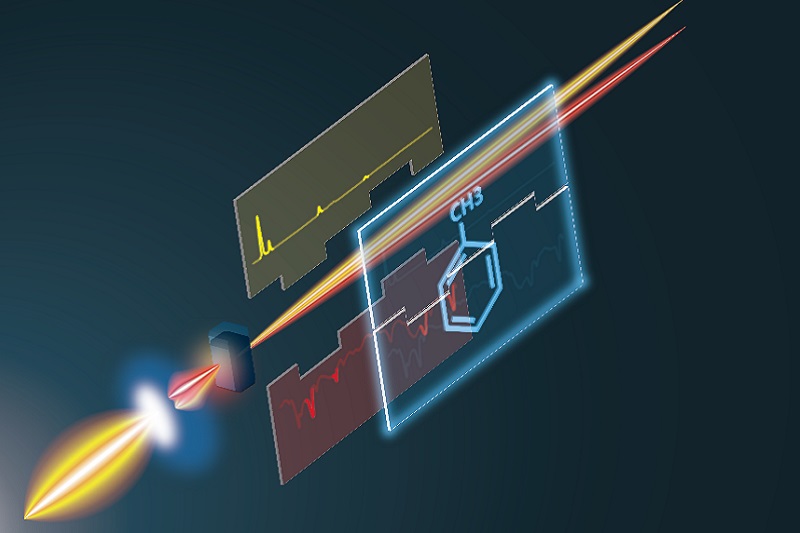A laser, a crystal and molecular structures New tool uses wider light spectrum to identify molecules Research news


Artist's representation of complementary vibrational spectroscopy. The new technique of complementary vibrational spectroscopy relies on improvements in ultrashort pulsed laser technology. © Takuro Ideguchi, CC BY-ND-4.0
Researchers have built a new tool to study molecules using a laser, a crystal and light detectors. This new technology will reveal nature's smallest sculptures - the structures of molecules - with increased detail and specificity.
"We live in the molecular world where most things around us are made of molecules: air, foods, drinks, clothes, cells and more. Studying molecules with our new technique could be used in medicine, pharmacy, chemistry, or other fields," said Associate Professor Takuro Ideguchi from the University of Tokyo Research Institute for Photon Science and Technology.
The new technique combines two current technologies into a unique system called complementary vibrational spectroscopy. All molecules have very small, distinctive vibrations caused by the movement of the atoms' nuclei. Tools called spectrometers detect how those vibrations cause molecules to absorb or scatter light waves. Current spectroscopy techniques are limited by the type of light that they can measure.
The new complementary vibrational spectrometer designed by researchers in Japan can measure a wider spectrum of light, combining the more limited spectra of two other tools, called infrared absorption and Raman scattering spectrometers. Combining the two spectroscopy techniques gives researchers different and complementary information about molecular vibrations.

Schematic of complementary vibrational spectroscopy, which is based on a dual-modal Fourier-transform spectrometer with an ultrashort pulsed laser. The Raman measurement is made by Fourier-transform coherent Raman scattering spectroscopy. The infrared measurement is made by Fourier-transform infrared absorption spectroscopy with infrared light generated at a nonlinear crystal. © Takuro Ideguchi, originally published in Nature Communications DOI: 10.1038/s41467-019-12442-9
"We questioned the 'common sense' of this field and developed something new. Raman and infrared spectra can now be measured simultaneously," said Ideguchi.
Previous spectrometers could only detect light waves with lengths from 0.4 to 1 micrometer (Raman spectroscopy) or from 2.5 to 25 micrometers (infrared spectroscopy). The gap between them meant that Raman and infrared spectroscopy had to be performed separately. The limitation is like trying to enjoy a duet, but being forced to listen to the two parts separately.
Complementary vibrational spectroscopy can detect light waves around the visible to near-infrared and mid-infrared spectra. Advancements in ultrashort pulsed laser technology have made complementary vibrational spectroscopy possible.
Inside the complementary vibrational spectrometer, a titanium-sapphire laser sends pulses of near-infrared light with the width of 10 femtoseconds (10 quadrillionths of a second) towards the chemical sample. Before hitting the sample, the light is focused onto a crystal of gallium selenide. The crystal generates mid-infrared light pulses.

Complementary vibrational spectra of toluene (a chemical common in paint thinner). The combined complementary vibrational spectroscopy results (red and blue lines) are on par with the standard reference results of two separate technologies, infrared spectroscopy (top black line) and Raman scattering spectroscopy (bottom black line). © Takuro Ideguchi, originally published in Nature Communications DOI: 10.1038/s41467-019-12442-9
So far, researchers have tested their new technique on samples of pure chemicals commonly found in science labs. They hope that the technique will one day be used to understand how molecules change shape in real time.
"Especially for biology, we use the term 'label-free' for molecular vibrational spectroscopy because it is noninvasive and we can identify molecules without attaching artificial fluorescent tags. We believe that complementary vibrational spectroscopy can be a unique and useful technique for molecular measurements," said Ideguchi.
Papers
Hashimoto K., Badarla V.R., Kawai A., and Ideguchi T., "Complementary Vibrational Spectroscopy," Nature Communications: September 27, 2019, doi:10.1038/s41467-019-12442-9.
Link (Publication )
)





